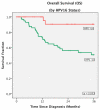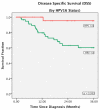Evaluation of human papilloma virus diagnostic testing in oropharyngeal squamous cell carcinoma: sensitivity, specificity, and prognostic discrimination
- PMID: 21969383
- PMCID: PMC3188400
- DOI: 10.1158/1078-0432.CCR-11-0388
Evaluation of human papilloma virus diagnostic testing in oropharyngeal squamous cell carcinoma: sensitivity, specificity, and prognostic discrimination
Abstract
Purpose: Human papillomavirus-16 (HPV16) is the causative agent in a biologically distinct subset of oropharyngeal squamous cell carcinoma (OPSCC) with highly favorable prognosis. In clinical trials, HPV16 status is an essential inclusion or stratification parameter, highlighting the importance of accurate testing.
Experimental design: Fixed and fresh-frozen tissue from 108 OPSCC cases were subject to eight possible assay/assay combinations: p16 immunohistochemistry (p16 IHC); in situ hybridization for high-risk HPV (HR HPV ISH); quantitative PCR (qPCR) for both viral E6 RNA (RNA qPCR) and DNA (DNA qPCR); and combinations of the above.
Results: HPV16-positive OPSCC presented in younger patients (mean 7.5 years younger, P = 0.003) who smoked less than HPV-negative patients (P = 0.007). The proportion of HPV16-positive cases increased from 15% to 57% (P = 0.001) between 1988 and 2009. A combination of p16 IHC/DNA qPCR showed acceptable sensitivity (97%) and specificity (94%) compared with the RNA qPCR "gold standard", as well as being the best discriminator of favorable outcome (overall survival P = 0.002). p16 IHC/HR HPV ISH also had acceptable specificity (90%) but the substantial reduction in its sensitivity (88%) impacted upon its prognostic value (P = 0.02). p16 IHC, HR HPV ISH, or DNA qPCR was not sufficiently specific to recommend in clinical trials when used in isolation.
Conclusions: Caution must be exercised in applying HPV16 diagnostic tests because of significant disparities in accuracy and prognostic value in previously published techniques.
©2011 AACR
Figures


References
-
- Ferlay J, Shin HR, Bray F, Forman D, Mathers C, Parkin DM. Estimates of worldwide burden of cancer in 2008: GLOBOCAN 2008. Int J Cancer. 2010 - PubMed
-
- Sturgis EM, Cinciripini PM. Trends in head and neck cancer incidence in relation to smoking prevalence: an emerging epidemic of human papillomavirus-associated cancers? Cancer. 2007;110:1429–35. - PubMed
-
- Conway DI, Stockton DL, Warnakulasuriya KA, Ogden G, Macpherson LM. Incidence of oral and oropharyngeal cancer in United Kingdom (1990-1999) -- recent trends and regional variation. Oral Oncol. 2006;42:586–92. - PubMed
-
- Price G, Roche M, Crowther R, Wight R. Profile of Head and Neck Cancers in England - Incidence, Mortality and Survival. United Kingdom; Oxford: May 4, 2010. 2010.
Publication types
MeSH terms
Substances
Grants and funding
LinkOut - more resources
Full Text Sources
Medical

